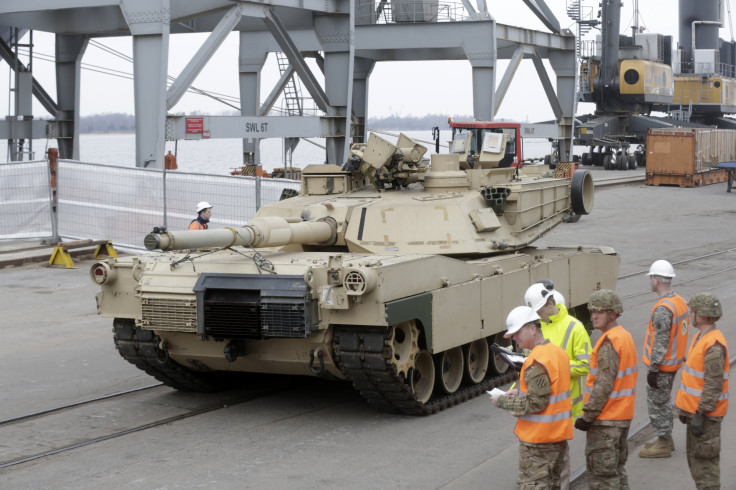Here's Who Will Compete To Build The Army's First Robotank

The U.S. Army is investing in robot tanks, launching a competition to design and build an uncrewed battle vehicle.
The project is more focused on research and development than it is on massive deployment, and we are a long way from seeing a robot battalion marching into battle. But as the world moves increasingly toward automation and artificial intelligence, the contractors involved now could be laying the foundation for significant future roles -- and revenue.
A step toward a Terminator Army?
The U.S. Army, via the National Advanced Mobility Consortium of industry and academic researchers, has selected four industry teams to battle in the Light Robotic Combat Vehicle competition. The contenders include two large U.S. publicly traded companies, Textron (NYSE:TXT) and Oshkosh (NYSE:OSK), as well as submissions from British robotics firm QinetiQ and privately held HDT Global.
The four teams will build prototypes of their proposed vehicles to be evaluated and tested, with the Army hoping to deploy the winning robotank in the field as soon as 2028.
This competition is for a "light" vehicle designed to carry only limited weaponry, to be loaded with sensors for intelligence gathering and improved battlefield views, and to be used as a communications node. If all goes to planned, larger and better-armed versions will eventually follow.
The use case for these vehicles is similar to that of the "loyal wingman" drone program being pursued by the Air Force. The robots would be designed to scout and even make initial contact with an enemy, giving field commanders more information about what they are up against and helping them make more informed decisions about how to proceed. The vehicles would provide extra and more expendable capacity to overwhelm enemy defenses and to navigate areas too dangerous for crewed vehicles.
The robots, at least for now, will be remotely controlled by human operators, but the Army hopes to increase their capabilities via artificial intelligence enhancements over time.
The contenders
The companies involved in the competition come to the fight with different skill sets. Oshkosh Defense is the manufacturer of the Joint Light Tactical Vehicle, a Humvee replacement, and has decades of experience manufacturing military-grade wheeled vehicles. It also has been dabbling in autonomous vehicles via a convoy system it is developing.
Textron, meanwhile, has a large and growing defense business making drones, helicopters, and land-based products and has been among the leaders in efforts to automate warships. The company telegraphed its interest in robotanks last year when it acquired privately held Howe & Howe, a maker of unmanned ground vehicles used by the military and by Hollywood. Textron is submitting a version of Howe & Howe's existing Ripsaw vehicle in the competition.
FLIR Systems (NASDAQ:FLIR), a maker of thermal imaging cameras and other sensors, is working with Textron on its bid. Lisa Atherton, president of Textron's defense business, in announcing the company's bid, played up the balance between cutting-edge tech and a proven vehicle in making the case for Textron's entry.
"We formed this team based on our shared focus to serve this customer with disruptive ideas and proven experience, and we are dedicated to meeting and exceeding their requirements through the RCV program," Atherton said. "We are confident that the Ripsaw M5 is their ideal wingman, and that we can get these vehicles out into the field where they need them -- quickly."
HDT Global has an established business making a range of products including shelters, power generators, and trailers for the Army. It has been advancing its robotics expertise in recent years, including the development of its Hunter WOLF logistics robot, which is designed to carry up to 1,000 lbs. of cargo through difficult conditions. HDT intends to submit a modified version of the Hunter WOLF in this competition.
Finally, QinetiQ, a manufacturer of small robots, earlier this year won a $164 million U.S. Army contract to supply ground robots that fit into a soldier's backpack. The company is partnering with engineering firm Pratt & Miller, best known for its large presence in professional motorsports, for this competition. The two companies will submit a version of Pratt & Miller's Expeditionary Modular Autonomous Vehicle (EMAV), which has already attracted the interest of the Marine Corps.
Bigger than just one robot
This competition is relatively small compared to the multibillion-dollar procurements that come out of the Pentagon, but the ramifications for the eventual winner go well beyond this individual award. The nature of military contracting is evolving, and the companies that can establish their expertise today should benefit for years to come.
Through most of the postwar period, the largest paydays have gone to the defense companies with the specific manufacturing expertise to make planes and warships. While metal-bending skills will continue to be important, in recent years, the emphasis has been on who has the best cutting-edge designers and who has the tech know-how to build the electronic brains for ever-more-complex military platforms.
The robotank that comes out of this competition will be a relatively low-tech machine but with a powerful suite of sensors and advanced electronics and an interface that thousands of military personnel will train on and get acclimated to. In that sense, the winner here has a leg up on future automation competitions and real-world examples to use when pitching its products.
We are still far removed from the science-fiction scenario of robot armies meeting on the battlefield. But the company that emerges from this competition is well on its way to playing a major role in the Army's continuing push toward automation.
Lou Whiteman has no position in any of the stocks mentioned. The Motley Fool recommends Textron. The Motley Fool has a disclosure policy.
This article originally appeared in The Motley Fool.





















